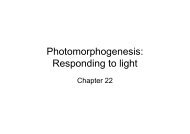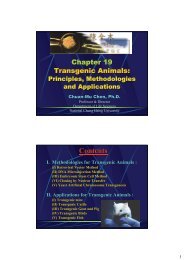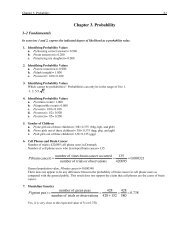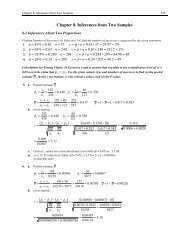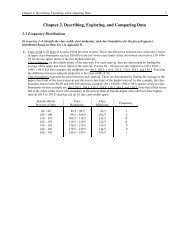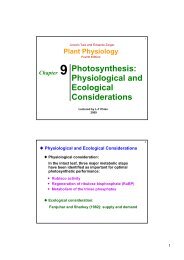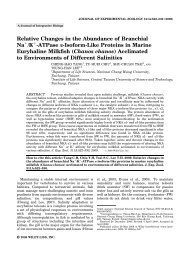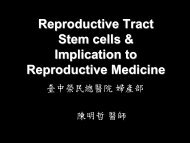Chapter 7. Hypothesis Testing with One Sample
Chapter 7. Hypothesis Testing with One Sample
Chapter 7. Hypothesis Testing with One Sample
You also want an ePaper? Increase the reach of your titles
YUMPU automatically turns print PDFs into web optimized ePapers that Google loves.
204 <strong>Chapter</strong> 7: <strong>Hypothesis</strong> <strong>Testing</strong> <strong>with</strong> <strong>One</strong> <strong>Sample</strong>38. Type I: Conclude there is sufficient evidence to support that the proportion of college graduate who smoke isless than 0.27 when in actuality p = 0.27Type II: Fail to reject that the proportion of college graduate who smoke is 0.27 when in actuality p < 0.2<strong>7.</strong>39. Type I: Conclude there is sufficient evidence to support that the proportion of fatal commercial aviationcrashes is different than 0.038 when in actuality p = 0.038Type II: Fail to reject that the proportion of fatal commercial aviation crashes is 0.038 when in actuality p ≠0.038.40. Type I: Conclude there is sufficient evidence to support that the proportion of M&Ms that are blue is differentthan 0.10 when in actuality p = 0.10Type II: Fail to reject that the proportion of M&Ms that are blue is 0.10 when in actuality p ≠ 0.10.41. The alternate hypothesis is H 1 p > 0.50, which makes this a right tailed test. The sample proportion isp ˆ = 0.27, which is less than 0.50. The test statistic is then negative. The critical region is to the right of z = 0,and so the test statistic cannot fall in the critical region, and so there is no chance to reject H 0 .42. Not necessarily. Since the significance 0.05 is larger than the significance 0.01, the critical values for α = 0.05are closer to z = 0 than those for α = 0.01. It is possible that the critical value for the hypothesis test fellbetween these critical values, and so was rejected at the 5% level and not at the 1% level. It is also possiblethat the test statistic was <strong>with</strong>in the critical region for α = 0.01 also, and so it may be that null hypothesis wasrejected at both significance levels.43. We follow the steps outlined in the problem:a. Step 1The significance level is 5%, this is a left tailed test, so the critical value is −z 0.05=−1.645.Step 2Solving for p ˆ , and substituting the values p=0.5, n = 1998, and q = 0.5, we findpq0.5⋅ 0.5p ˆ = p − z .05= 0.5−1.645n 1998 = 0.48Step 3We now find the area to the left of p ˆ , using the z-score based on a population proportion p = 0.45.z = p ˆ − p 0.48 − 0.45= = 2.70pq 0.45⋅ 0.55n 1998The area to the left of 2.70 is 0.9965, which is the power of the test. In this hypothesis test, it would be verylikely that we reject H 0 when the true population proportion is p = 0.45.b. β = (1 – 0.9965) = 0.003544. We will solve the problem by first solving the z score for p ˆ using the critical value for α = 0.05 and the nullhypothesis value for p = 0.04. Doing so, we see thatpq0.4 × 0.6p ˆ = p + z = 0.4 −1.645 = 0.4 − 0.80588 .n nnFor a power of 0.80, we need to find the number <strong>with</strong> 0.80 area to its left under the standard normal curve.Table A-2 gives the value z = -0.84.Now, using the alternate value for p = 0.3, we again solve for p ˆ .pq0.3× 0.7p ˆ = p + z = 0.3− 0.84 = 0.3− 0.38494 .n nnSetting the left hand sides equal to one another, we get the following equation.0.3− 0.38494 = 0.4 − 0.80589 .nn




